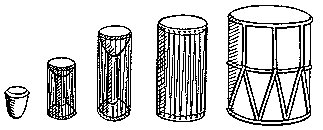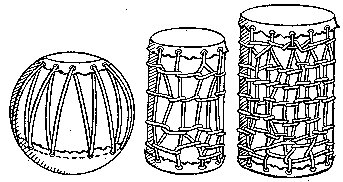|
TRANSLATIONS
So far so good, it seems, as we have inspected the beginning and the midsection of side a in Tahua, finding reasonable interpretations of some of the glyphs there; the idea of side a being a solar calendar has found support. We have, however, skipped over the period from spring equinox (identified as Aa3-44)
to the first of the 'waning' henua (Aa4-42):
In the process of inspecting the midsection of side a several more insights and ideas have emerged, for example does the missing face of the Egyptian smith suggest an explanation of the unseen - that indeed the unseen parts of a an illustration (e.g. a glyph) represents phenomena which cannot be seen. "... Like the sun, chiefs of the highest tabus - those who are called 'gods', 'fire', 'heat', and 'raging blazes' - cannot be gazed directly upon without injury. The lowly commoner prostrates before them face to the ground, the position assumed by victims on the platforms of human sacrifice. Such a one is called makawela, 'burnt eyes' ..." (Islands of History)
The celestial smith in the picture is the sun, of course, and the arrow in his hand represents his rays: "Since I was very curious to know whereof the preparations of these people might consist, I got up before sunrise and hid in some bushes near the clearing that the little fellows had chosen the night before for their preparations. When it was still dark the men arrived; but not alone. They were accompanied by the woman. The men crouched on the ground and cleared the area of all bits of growth, after which they smoothed it flat. One of them then drew something in the sand with his finger, while the other men and the woman muttered formulae of some kind and prayers; after which silence fell, while they waited for something. The sun appeared on the horizon. One of the men, with an arrow in his drawn bow, stepped over to the cleared ground. In a couple of moments the rays of the sun struck the drawing and at the same instant the following took place at lightning speed: the woman lifted her hands as though reaching for the sun and uttered loudly some unintelligible syllables; the man released his arrow; the woman cried out again; then the men dashed into the forest with their weapons. The woman remained standing a few minutes and then returned to the camp. When she had left, I came out of my hiding and saw that what had been drawn on the ground was an antelope, some four feet long and the arrow was stuck in its neck." (Frobenius according to Campbell) This little story is very 'illuminating' and we immediately should understand the connection between mother earth and the woman lifting her hands 'as though reaching for the sun':
I guess that not only the en face variant of GD15 (which we have identified as the 'noon' sun), but also the more frequent 'head seen sideways' variant do represent the sun:
The Egyptians personified the sun as a smith (among several other 'persons') and it is not unreasonable to assume that the Easter Islanders did so too. Indeed, the Egyptian smith picture - or a similar one - could be the origin of the 'head seen sideways' variant of GD15. The open mouth which always is there may be an echo of the missing 'face' of the sun. Maybe the influence of the Egyptians stretched all the way over time and space to Easter Island? If there was an influence - which the evidence seems to tell us - then it could very well be an indirect influence: "...and then, with stunning abruptness, at a crucial date that can be almost precisely fixed at 3200 BC (in the period of the archaeological stratum known as Uruk B), there appears in this little Sumerian mud garden - as though the flowers of its tiny cities were suddenly bursting into bloom - the whole cultural syndrome that has since constituted the germinal unit of all the high civilization of the world. And we cannot attribute this event to any achievement of the mentality of simple peasants. Nor was it the mechanical consequence of a simple piling up of material artifacts, economically determined. It was actually and clearly the highly conscious creation (this much can be asserted with complete assurance) of the mind and science of a new order of humanity, which had never before appeared in the history of mankind; namely, the professional, full-time, initiated, strictly regimented temple priest. The new inspiration of civilized life was based, first, on the discovery, through long and meticulous, carefully checked and rechecked observations, that there were, besides the sun and moon, five other visible or barely visible heavenly spheres (to wit, Mercury, Venus, Mars, Jupiter, and Saturn) which moved in established courses, according to established laws, along the ways followed by the sun and moon, among the fixed stars; and then, second, on the almost insane, playful, yet potentially terrible notion that the laws governing the movements of the seven heavenly spheres should in some mystical way be the same as those governing the life and thought of men on earth. The whole city, not simply the temple area, was now conceived as an imitation on earth of the cosmic order, a sociological 'middle cosmos', or mesocosm, established by priestcraft between the macrocosm of the universe and the microcosm of the individual, making visible the one essential form of all. The king was the center, as a human representative of the power made celestially manifest either in the sun or the moon, according to the focus of the local cult; the walled city was organized architecturally in the design of a quartered circle (like the circles designed on the ceramic ware of the period just preceeding), centered around the pivotal sanctum of the palace or ziggurat (as the ceramic designs around the cross, rosette, or swastika); and there was a mathematically structured calendar to regulate the seasons of the city's life according to the passages of the sun and moon among the stars - as well as a highly developed system of liturgical arts, including music, the art rendering audible to human ears the world-ordering harmony of the celestial spheres. It was at this moment in human destiny that the art of writing first appeared in the world and that scriptorially documented history therefore begins. Also, the wheel appeared. And we have evidence of the development of the two numerical systems still normally employed throughout the civilized world, the decimal and the sexigesimal; the former was used mostly for business accounts in the offices of the temple compounds, where the grain was stored that had been collected as taxes, and the latter for the ritualistic measuring of space and time as well. Three hundred and sixty degrees, then as now, represented the circumference of a circle - the cycle of the horizon - while three hundred and sixty days, plus five, marked the measurement of the circle of the year, the cycle of time. The five intercalated days that bring the total to three hundred and sixty-five were taken to represent a sacred opening though which spiritual energy flowed into the round of the temporal universe from the pleroma of eternity, and they were designated, consequently, days of holy feast and festival. Comparably, the ziggurat, the pivotal point in the center of the sacred circle of space, where the earthly and heavenly powers joined, was also characterized by the number five; for the four sides of the tower, oriented to the points of the compass, came together at the summit, the fifth point, and it was there that the energy of heaven met the earth. The early Sumerian temple tower with the hieratically organized little city surrounding it, where everyone played his role according to the rules of a celestially inspired divine game, supplied the model of paradise that we find, centuries later, in the Hindu-Buddhist imagery of the world mountain, Sumeru, whose jeweled slopes, facing the four directions, peopled on the west by sacred serpents, on the south by gnomes, on the north by earth giants, and on the east by divine musicians, rose from the mid-point of the earth as the vertical axis of the egg-shaped universe, and bore on its quadrangular summit the palatial mansions of the deathless gods, whose towered city was known as Amaravati, 'The Town Immortal'. But it was the model also of the Greek Olympus, the Aztec temples of the sun, and Dante's holy mountain of Purgatory, bearing on its summit the Earthly Paradise. For the form and concept of the City of God conceived as a 'mesochosm' (an earthly imitation of the celestial order of the macrocosm) which emerged on the threshold of history circa 3200 BC, at precisely that geographical point where the rivers of Tigris and Euphrates reach the Persian Gulf, was disseminated eastward and westward along the ways already blazed by the earlier neolithic. The wonderful life-organizing assemblage of ideas and principles - including those of kingship, writing, mathematics, and calendrical astronomy - reached the Nile, circa 2800 BC; it spread to Crete on the one hand, and on the other, to the valley of the Indus, circa 2600 BC; to Shang China, circa 1600 BC; and, according to at least one high authority, Dr Robert Heine-Geldern, from China across the Pacific, during the prosperous seafaring period of the late Chou Dynasty, between the seventh and fourth centuries BC, to Peru and Middle America." (Campbell) If there was such a great diffusion, then it is not surprising to find similarities in thoughts and ideas all over our globe. We should listen everywhere: "The most important of all drums, he said, was the armpit drum. The Nummo made it. It consists of two hemispherical wooden cups connected through their centres by a slender cylinder. It is like an hour-glass with a very long narrow neck. With this instrument tucked between his left arm and armpit, the drummer, by pressing on the hollow structure of thin wood, can tighten or relax the tension on the skins and so modify the tone. 'The Nummo made it. He made a picture of it with is fingers, as children do today in games with string.' Holding his hands apart, he passed a thread ten times round each of the four fingers, but not the thumb. He thus had forty loops on each hand, making eighty threads in all, which, he pointed out, was also the number of teeth of his jaws. The palms of his hands represented the skins of the drum, and thus to play on the drum was, symbolically, to play on the hands of the Nummo. But what do they represent? Cupping his two hands behind his ears, OgotemmÍli explained that the spirit had no external ears but only auditory holes. 'His hands serve for ears,' he said; 'to enable him to hear he always holds them on each side of his head. To tap the drum is to tap the Nummo's palms, to tap, that is, his ears.' Holding before him the web of threads which represented a weft, the Spirit with his tongue interlaced them with a kind of endless chain made of a thin strip of copper. He coiled this in a spiral of eighty turns, and throughout the process he spoke as he had done when teaching the art of weaving. But what he said was new. It was the third Word, which he was revealing to men." (OgotemmÍli)
|






